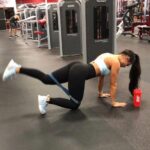When it comes to staying fit and healthy, having a well-rounded fitness routine is crucial. But what exactly is a fitness routine? In this article, we will explore the concept of a fitness routine, its benefits, components, and how to create a personalized plan that suits your goals and lifestyle.
A fitness routine can be defined as a structured program of physical activities and exercises that are performed regularly to improve overall health and fitness. Whether you’re aiming to lose weight, build strength, or simply stay active, having a consistent fitness routine can help you achieve your goals and maintain a healthy lifestyle.
In the following sections, we will delve into the many benefits of having a regular fitness routine, discuss the essential components of a well-rounded routine, provide tips for creating a personalized plan, and offer sample beginner, intermediate, and advanced routines to get you started on your fitness journey. So let’s dive in and discover what it takes to establish and maintain an effective fitness routine.
Benefits of Having a Regular Fitness Routine
Engaging in a regular fitness routine offers numerous benefits for both physical and mental health. From improving cardiovascular endurance to boosting mood and reducing stress, making exercise a consistent part of your life can lead to a wide range of positive outcomes.
Physical Health Benefits
One of the most significant benefits of maintaining a regular fitness routine is the positive impact it has on your physical health. Regular exercise can help you manage and prevent a variety of health conditions, including heart disease, diabetes, and obesity. It also promotes better sleep, boosts energy levels, and enhances overall strength and flexibility.
Mental Health Benefits
In addition to the physical benefits, a regular fitness routine also has positive effects on mental well-being. Exercise has been shown to reduce symptoms of anxiety and depression, improve cognitive function, and enhance self-esteem. The release of endorphins during physical activity can also create feelings of happiness and relaxation.
Social Benefits
Maintaining a regular fitness routine can also help you connect with others who share similar interests. Whether it’s joining a group fitness class or finding a workout buddy, exercising with others can provide social support and accountability that makes sticking to your routine more enjoyable. This social aspect can increase motivation and make the entire experience more fulfilling.
By understanding the various benefits that come with having a regular fitness routine, individuals can find additional motivation to prioritize their physical well-being. Whether it’s improved physical health, mental wellness, or social connections, these rewards serve as strong incentives for establishing and maintaining consistent exercise habits.
Components of a Well-Rounded Fitness Routine
A well-rounded fitness routine consists of four main components: cardio, strength training, flexibility, and balance. Each component plays a crucial role in improving overall health and physical fitness.
Cardiovascular Exercise
Cardio, short for cardiovascular exercise, is any type of workout that increases your heart rate and improves the function of your heart and lungs. Examples of cardio exercises include running, cycling, swimming, and aerobics. Cardio workouts help to improve endurance, burn calories, and reduce the risk of chronic diseases such as heart disease and diabetes.
Strength Training
Strength training involves using resistance to build muscle mass and increase strength. This can be achieved through weightlifting, bodyweight exercises, or using resistance bands. Strength training not only helps to sculpt and tone the body but also improves bone density and metabolism.
Flexibility and Balance
Flexibility exercises such as yoga or stretching help to improve range of motion in the joints and reduce the risk of injury. Balance exercises such as tai chi or standing on one foot can help prevent falls especially in older adults. Both flexibility and balance are essential components of a well-rounded fitness routine that often get overlooked.
Incorporating each of these components into your fitness routine can lead to improved overall health, increased energy levels, better sleep quality, and a reduced risk of chronic illnesses. A balanced routine ensures that all aspects of physical fitness are addressed for a comprehensive approach to overall well-being.
Creating a Personalized Fitness Routine
When it comes to starting a fitness routine, one size certainly does not fit all. Before jumping into any type of exercise regimen, it’s important to take the time to assess your personal goals, current fitness level, and schedule. By tailoring your routine to your individual needs and abilities, you can increase the likelihood of sticking with it long-term and seeing the results you desire.
First and foremost, take some time to think about what you hope to achieve through your fitness routine. Whether it’s losing weight, gaining muscle, increasing flexibility, or simply improving overall endurance and health, having a clear goal in mind will help guide the specific activities you choose to include in your routine. It’s also important to set realistic and measurable goals so that you can track your progress over time.
Next, honestly evaluate your current fitness level. This includes taking into consideration any existing health conditions or physical limitations that may impact the types of exercises you can safely engage in. If you’re just starting out or returning to exercise after a long period of inactivity, it’s wise to start slow and gradually build up intensity and duration as your body becomes stronger and more accustomed to regular physical activity.
Finally, consider your daily schedule and determine how much time you can realistically devote to exercise each week. Finding a balance between work, family obligations, and other commitments is essential for creating a fitness routine that is sustainable for the long haul.
Whether it’s carving out small pockets of time throughout the day or dedicating longer sessions on certain days of the week, being mindful of how exercise fits into your overall lifestyle will help ensure that it becomes a top priority.
| Assessment Factors | Considerations |
|---|---|
| Goals | Weight loss, muscle gain, flexibility improvement |
| Fitness Level | Health conditions, physical limitations |
| Schedule | Daily availability for exercise |
Sample Beginner, Intermediate, and Advanced Fitness Routines
When starting a fitness routine, it can be overwhelming to know where to begin. That’s why we’ve put together sample beginner, intermediate, and advanced fitness routines to help you get started at any level of fitness. Before beginning any new exercise program, it’s important to consult with a healthcare professional to ensure that it is safe for you.
A beginner fitness routine should focus on building a foundation of cardio endurance, strength, flexibility, and balance. This can include activities such as walking or light jogging for cardio, bodyweight exercises or resistance band training for strength, yoga or stretching for flexibility, and simple balance exercises like standing on one foot or practicing Tai Chi. The goal is to start slowly and gradually increase the intensity as your body becomes more accustomed to exercise.
For those at an intermediate level of fitness, the routine can become more varied and challenging. Incorporating higher intensity cardio workouts such as running or cycling, weight lifting for strength training, more advanced yoga poses for flexibility, and incorporating exercises that challenge balance such as single leg squats or stability ball exercises are all great options. It’s also important to include rest days in between workouts to allow your body time to recover.
Advanced fitness routines are designed for those who have been consistently exercising and have built a strong fitness foundation. Incorporating high-intensity interval training (HIIT) for cardio, heavy weight lifting or advanced bodyweight exercises for strength training, deep stretching techniques like PNF stretching for flexibility, and advanced balance exercises like Bosu ball workouts are all suitable choices.
It’s important at this level to also pay close attention to proper nutrition and hydration in order to support the increased demands placed on the body during advanced workouts.
| Fitness Level | Sample Activities |
|---|---|
| Beginner | Walking/jogging, bodyweight exercises/resistance bands, yoga/stretching |
| Intermediate | Running/cycling/interval training, weight lifting/advanced bodyweight exercises – yoga/deep stretching/PNF stretching |
| Advanced | HIIT/advanced cardio – heavy weight lifting/advanced bodyweight exercises – advanced yoga/PNF/stretching – Bosu ball/stability ball workouts |
Tips for Staying Motivated and Sticking to a Fitness Routine
Staying motivated and sticking to a fitness routine can be a challenge, especially when life gets hectic or when progress seems slow. However, there are several strategies that can help individuals maintain their dedication to their fitness goals.
One effective way to stay motivated is by setting specific, achievable goals. Having concrete targets to work towards can give individuals a sense of purpose and direction in their fitness journey. Whether it’s running a certain distance, lifting a particular weight, or mastering a challenging yoga pose, setting milestones can provide the motivation needed to stay committed to a fitness routine.
Another helpful tip for staying on track with a fitness routine is finding an accountability partner or joining an exercise group. Having someone to work out with not only makes exercising more enjoyable, but also provides encouragement and support when motivation wavers. Additionally, being part of a community of like-minded individuals can create a sense of camaraderie and shared determination, making it easier to stick to a fitness routine.
Finally, keeping workouts varied and interesting is essential for preventing boredom and maintaining motivation. Incorporating different activities such as cycling, swimming, dance classes or outdoor sports into the fitness routine not only keeps things fresh and exciting but also ensures that the body continues to be challenged in different ways. A dynamic approach to exercise helps keep motivation high and increases the likelihood of sticking with it in the long run.
Common Mistakes to Avoid When Establishing a Fitness Routine
When establishing a fitness routine, it’s important to be mindful of common mistakes that can hinder your progress and motivation. Avoiding these pitfalls can help you stay on track and achieve your fitness goals more effectively. Here are some common mistakes to steer clear of:
- Overtraining: One common mistake many people make when starting a fitness routine is overdoing it. Pushing yourself too hard without allowing for adequate rest and recovery can lead to injury and burnout. It’s important to listen to your body and give yourself permission to take breaks when needed.
- Setting Unrealistic Goals: Another mistake is setting unattainable goals. While it’s great to aim high, setting goals that are too ambitious can be discouraging when you don’t see immediate results. It’s important to set realistic, achievable goals and celebrate small victories along the way.
- Ignoring Proper Nutrition: A fitness routine should be complemented by a healthy diet. Neglecting proper nutrition can sabotage your efforts in the gym. Make sure to fuel your body with the right balance of macronutrients and stay hydrated for optimal performance and recovery.
In addition, here are other common mistakes people make when establishing a fitness routine:
- Skipping Warm-Ups and Cool-Downs
- Not Varying Your Exercises
- Comparing Yourself to Others
By being aware of these common mistakes, you can proactively avoid them and set yourself up for success in your fitness journey. Remember that consistency, patience, and balance are key components of a sustainable fitness routine.
How to Switch Up Your Fitness Routine to Avoid Plateaus and Boredom
Switching up your fitness routine is essential to avoid plateaus and boredom. When you do the same exercises day in and day out, your body becomes accustomed to them, leading to a decrease in the effectiveness of your workouts. Additionally, doing the same routine can get monotonous, making it difficult to stay motivated. Here are some tips on how to switch up your fitness routine:
- Try Different Workouts: Incorporate various types of exercises into your routine such as yoga, pilates, kickboxing, or dancing. Engaging in different activities challenges your muscles in new ways and keeps things interesting.
- Change Your Reps and Sets: If you’ve been doing the same number of reps and sets for a while, it’s time to change it up. Adjusting the weight and number of repetitions can shake things up and prevent stagnation.
- Explore New Equipment: Incorporating different types of equipment like kettlebells, resistance bands, or medicine balls into your routine can provide a fresh stimulus for your muscles.
By implementing these changes into your fitness routine, you can keep workouts challenging and exciting while continuing to see progress.
It’s also important to listen to your body when switching up your fitness routine. Don’t push yourself too hard or get discouraged if you’re not seeing immediate results. Give yourself time to adapt to the new changes and stay consistent with your workouts. Remember that avoiding plateaus and staying engaged with exercise is a long-term process rather than an overnight fix, so be patient with yourself as you experiment with different workout variations.
Conclusion
In conclusion, understanding what a fitness routine is can be the first step in taking charge of your physical health. By implementing a regular fitness routine into your lifestyle, you can experience a wide range of benefits that contribute to your overall well-being. From improved cardiovascular health and increased strength to better flexibility and balance, the components of a well-rounded fitness routine offer numerous advantages for your body.
It’s important to remember that everyone’s fitness journey is unique, and creating a personalized fitness routine that aligns with your specific goals, fitness level, and schedule is crucial for long-term success. Additionally, finding ways to stay motivated and making adjustments as needed will help you maintain consistency in your regimen. Avoiding common mistakes and knowing how to mix up your routine can also prevent plateaus and keep things interesting.
Prioritizing a consistent fitness routine is not just about physical appearance or performance; it’s about investing in your overall health and well-being. By committing to regular exercise, you are taking proactive steps towards leading a healthier lifestyle. So, whether you’re just starting out or looking to enhance an established routine, recognizing the significance of prioritizing consistent fitness is essential for achieving lasting results.
Frequently Asked Questions
How Do I Create a Fitness Routine?
Creating a fitness routine involves setting realistic goals, choosing activities you enjoy, and scheduling regular workouts. It’s important to include a mix of cardio, strength training, and flexibility exercises to ensure a well-rounded routine.
What Does a Good Fitness Routine Look Like?
A good fitness routine includes a balance of cardiovascular exercise, strength training, and flexibility work. It should be tailored to your individual fitness level and goals, with variety to prevent boredom and plateaus. Consistency is key in maintaining a good fitness routine.
What Is a Fitness Schedule?
A fitness schedule is a plan that outlines when and what type of exercise you will do on specific days. It helps keep you organized and accountable, ensuring that all aspects of fitness are addressed regularly. A well-structured schedule can help you stay on track and make progress towards your fitness goals.

Passionate about providing useful information to anyone with an interest in the field of Personal Training, I strive to pass on to our readers quality information and to answer any questions about Personal Trainers, the work they do and how to become one.





